Yamaha True X Surround 90A vs Samsung HW-Q990F: which premium soundbar system should you buy?
Two full soundbar packages with plenty to offer, but which one is worthy of your living room?

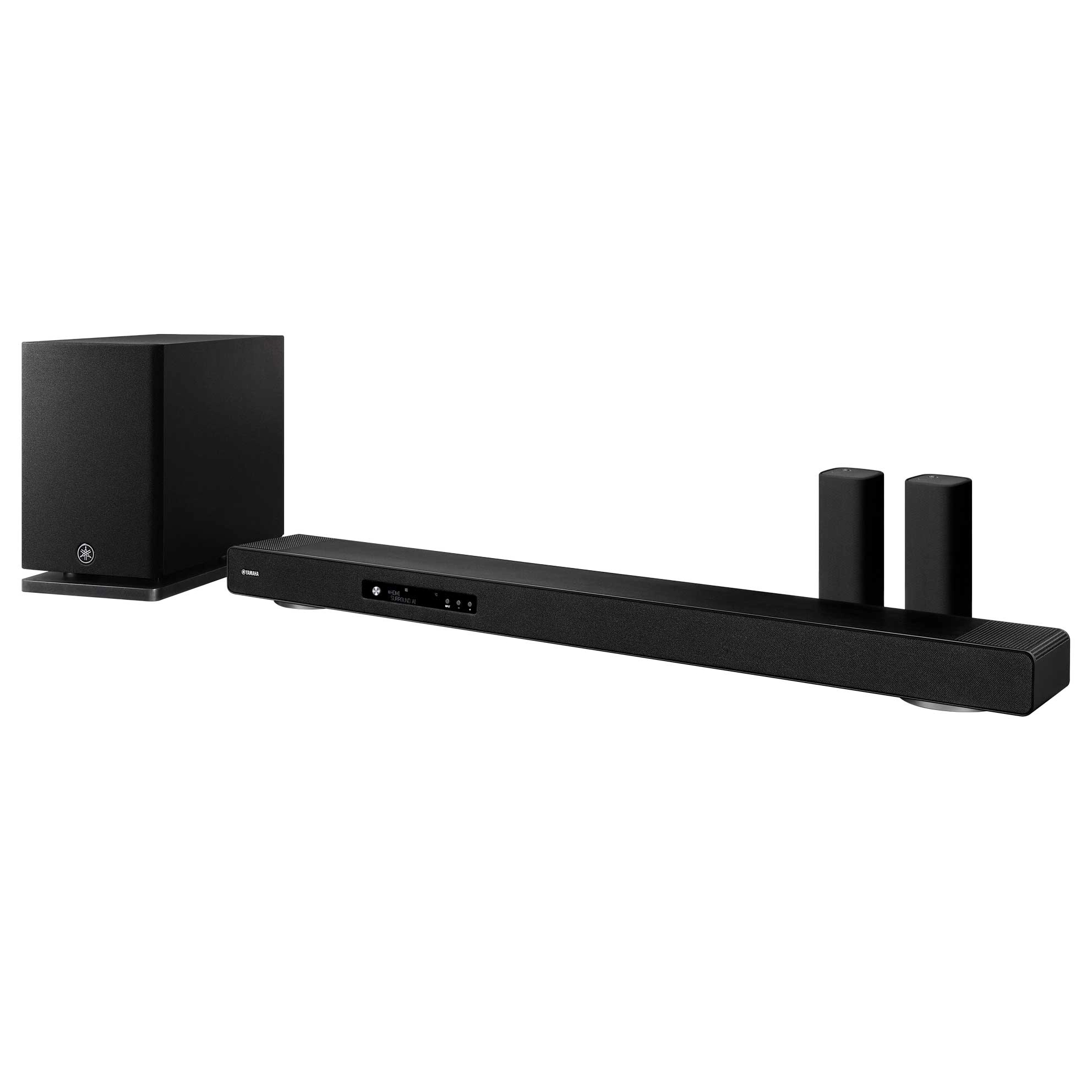
Connections: HDMI out (eARC), HDMI 2.0 in, optical, wi-fi, Bluetooth 5.0, AirPlay 2
ARC/eARC: eARC
Bluetooth: Yes
Dimensions (hwd): 8.5 x 118 x 14.3cm (soundbar)
Weight: 11kg (soundbar)
Yamaha's complete system includes a soundbar, wireless subwoofer, and two wireless surround speakers. The soundbar and sub deliver powerful, detailed sound with superb bass performance, but the surrounds hold the package back with a beamy delivery and tonal mismatch that creates gaps in the soundstage.
Pros
- Rich and powerful sound from the soundbar
- Well-controlled and dynamic subwoofer
- Music sounds detailed, well-timed and engaging
Cons
- Surround speakers are at odds with the rest of the system
- Large and heavy build won’t suit all set-ups
- Complex set-up menus and no auto-calibration
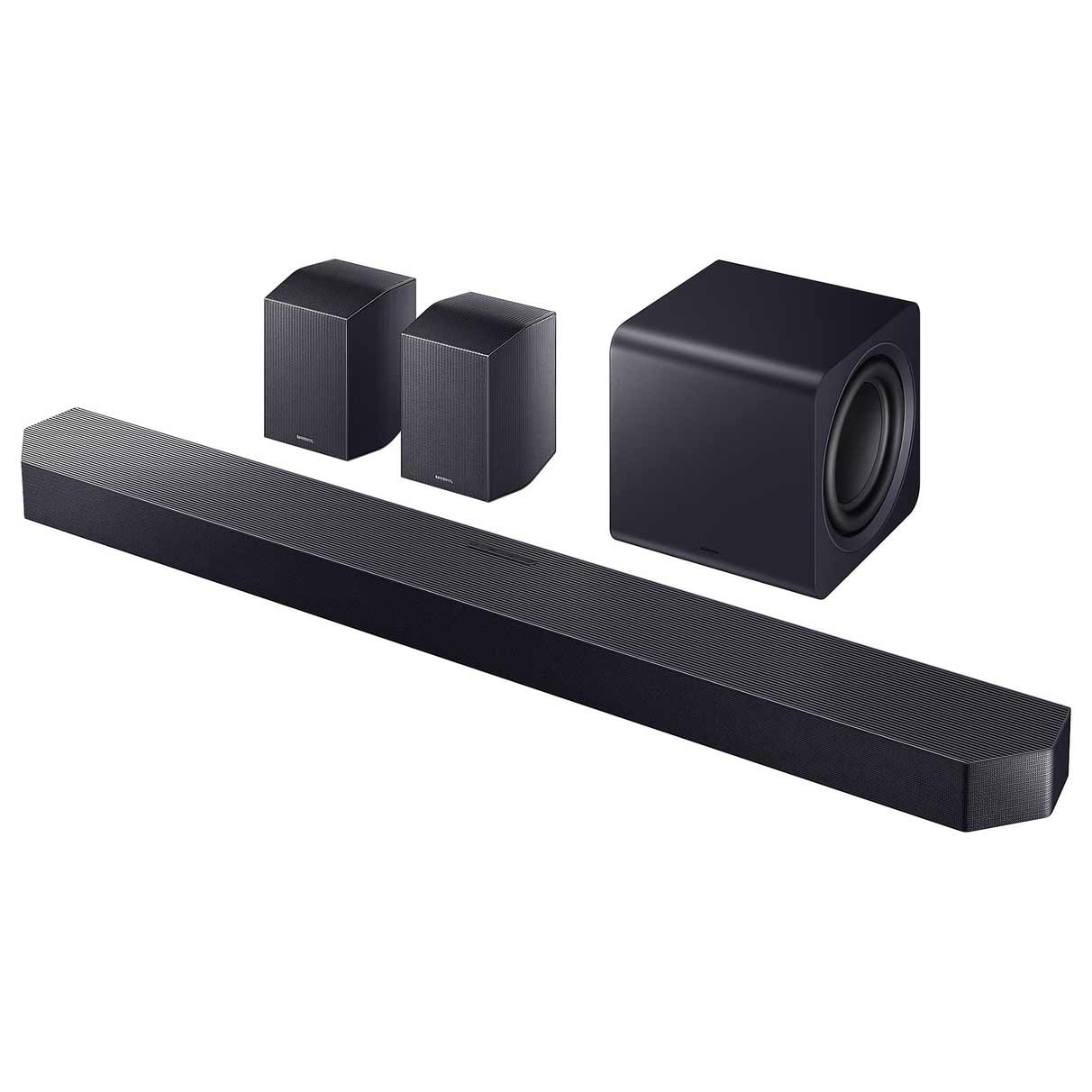
Connections: HDMI out (eARC), 2 x HDMI 2.1 in, optical, wi-fi, Bluetooth 5.0, AirPlay 2
ARC/eARC: eARC
Bluetooth: Yes
Dimensions (hwd): 7 x 123 x 14cm (soundbar)
Weight: 7.3kg (soundbar)Samsung HW-Q990F
Samsung's soundbar system delivers a superb cinematic experience. The compact cube subwoofer is the star of the show, offering richer, more controlled bass with greater tonal variation than its predecessor. Combined with tonally matched surrounds and the main bar, it creates an encompassing bubble of sound that places Dolby Atmos effects with impressive accuracy.
Pros
- Clear, detailed and dynamic sound
- Rich, controlled and tonally varied bass
- Easy set-up with excellent connectivity
Cons
- Design is starting to look a little bit dated
- Dot matrix display is hard to read
If you’re looking for one of the best soundbars, there’s no shortage of options. And therein lies the problem. With so many to choose from, it can be a daunting task to sift through pages of specs to see which one deserves the coveted spot under your telly.
That’s where we come in. Below, you’ll find an in-depth comparison between two compelling soundbar packages in the form of the Yamaha True X Surround 90A and Samsung HW-Q990F.
Both offer complete premium packages including a soundbar, wireless subwoofer, and wireless surround speakers. We have tested both systems extensively to determine which delivers the superior cinematic experience for your money, so scroll on down, and see which one deserves your hard-earned cash.
Yamaha True X Surround 90A vs Samsung HW-Q990F: price
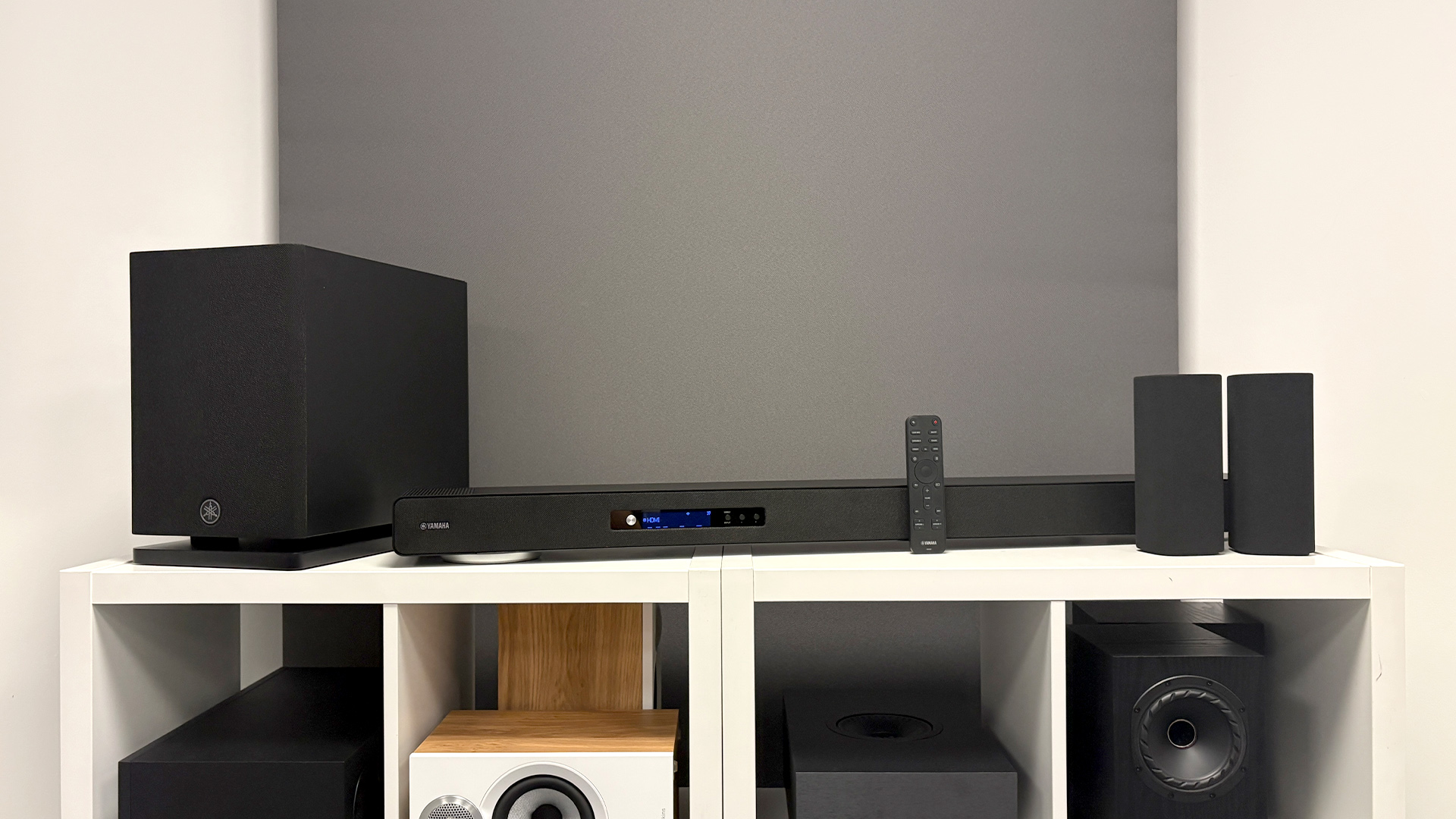
Launching at £2116 / $3500 / AU$4499, the Yamaha True X Surround 90A demanded a substantial investment when it first hit shelves, with the complete package including a soundbar, wireless subwoofer, and two wireless surround speakers. At the time of writing though, it can be yours for substantially less, with UK buyers currently able to snap it up in the £779-£800 range.
The Samsung HW-Q990F, also a complete soundbar, sub, and speaker package, launched at £1699 / $1999 / AU$1999 – significantly less than the Yamaha. Again, it can be yours for far less today, with a quick search indicating prices in the £857-£999 range.
At current price points, Samsung’s offer is slightly more expensive, potentially indicating its higher popularity. It did earn five stars in our review in comparison with the Yamaha’s four-star verdict, though it’s impossible to state what the precise reasons are for their current price disparities.
Either way, Yamaha’s offering can be had for a little less, giving it this first-round victory. But price is far from everything, especially if forking out a little extra for the Samsung kit provides a better overall experience.
The latest hi-fi, home cinema and tech news, reviews, buying advice and deals, direct to your inbox.
** Winner: Yamaha True X Surround 90A **
Yamaha True X Surround 90A vs Samsung HW-Q990F: design and build

The Yamaha True X Surround 90A makes no apologies for its substantial presence. The main soundbar is constructed entirely from a rigid metallic chassis supported by chunky resin feet designed to minimise cabinet vibrations. At 11kg, it's a hefty piece of kit. A fabric mesh fascia running along the front adds visual refinement, interrupted only by a small display and three interface buttons. Wall-mounting brackets are included if you prefer that approach.
The WS-X3A surround speakers take a more compact form, wrapped in grey fabric. At just 1kg each, they are unobtrusive and come with charging cradles, plus USB-C ports for wired charging. The 12.7kg subwoofer goes in the opposite direction – it’s a chunky black box that demands enough room for optimal placement.

Samsung's HW-Q990F follows the angular hexagonal design found in recent generations, with a lined pattern running along the top panel. At 7.3kg, the soundbar is lighter and lower-profile than the Yamaha, though slightly wider. The dot-matrix display on the front is simplistic compared to the Yamaha's screen, but Samsung includes on-screen menus for set-up, which proves more practical.
The surround speakers weigh 3.4kg each and maintain Samsung's boxy, angular design, with handy cable guides on the bottom edge. The real design departure comes with the subwoofer – Samsung has swapped the tall, narrow cuboid of previous models for a compact, rounded cube. Side by side, the old subwoofer absolutely dwarfs this new version.
Both systems are well constructed with solid build quality. The Yamaha's tank-like metallic chassis is impressive, while Samsung's components feel equally robust. However, Samsung's more compact footprint – particularly that diminutive subwoofer – will suit more living spaces.
Design and space constraints are all down to your personal preference and setup, making this round a tie.
** Winner: Draw **
Yamaha True X Surround 90A vs Samsung HW-Q990F: features
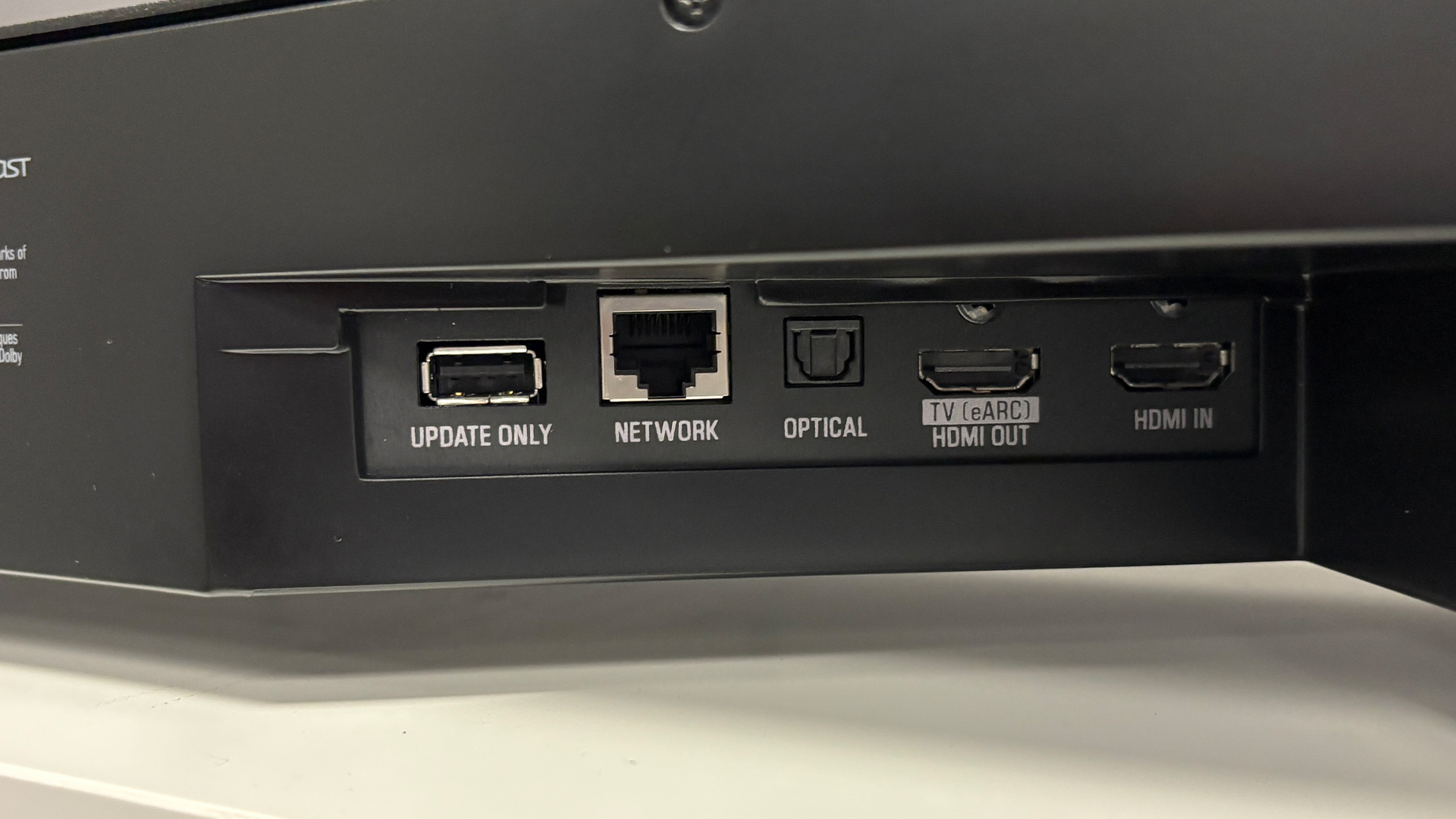
The Yamaha True X Surround 90A houses 19 drivers in the main soundbar. Four newly developed oval-shaped midrange drivers handle the bulk of the work – two in the centre, one at each end – supported by three dome tweeters. The real innovation sits on top – arrays of six beam-firing drivers at each end, derived from Yamaha's first soundbar from 2005, angled to project sound upwards and bounce it towards your seating position.
The WS-X3A surround speakers are simpler affairs, with just two 58mm full-range drivers each, backed by passive radiators. Both drivers face the same direction with no side-firing or up-firing units. The subwoofer employs an 18cm driver with Yamaha's new Symmetrical Flare Port technology, which is claimed to reduce port noise by 20dB.
Samsung counters with 23 drivers across its system – 15 in the main soundbar, three in each surround speaker, and dual 20cm force-cancelling drivers in the subwoofer. The soundbar and surrounds feature upward-firing drivers for Dolby Atmos height effects, which the Yamaha surrounds lack. Samsung recommends placing the rear speakers at a 135–150-degree angle behind the listening position, though the system compensates for different placements.
As for connectivity, the Yamaha offers HDMI eARC output and one HDMI 2.0 input with 4K passthrough – disappointingly not 4K/120Hz for gamers, though it does support Dolby Vision and HDR10+. There are also optical, USB (updates only), and ethernet sockets.
The Samsung provides HDMI eARC output and two HDMI 2.1 inputs rated for 4K/120Hz signals, plus HDR10+ and Dolby Vision support. Both include optical connections.
Format support is comprehensive on both. The Yamaha handles Dolby Atmos, DTS:X, and Auro 3-D. The Samsung covers Dolby Atmos and DTS:X, plus Eclipsa Audio – Samsung's partnership with Google for an open-source immersive format currently only accessible via YouTube.
Both offer wireless connectivity including Bluetooth and AirPlay 2, with streaming-service integration through their respective apps.
The Yamaha includes various sound modes – Clear Voice, Bass Extension, Straight, Stereo, and Yamaha's Surround:AI mode that adapts the soundfield via content recognition. Frustratingly, the system defaults to Auro 3-D's Auro-Scene upmixing regardless of native format, even for Dolby Atmos content. There's no automatic calibration or room correction either – instead, you're left wrestling with complex beam angle and focal length settings that lack clear descriptions.
Samsung takes a more user-friendly approach. SpaceFit Sound Pro uses built-in microphones which constantly monitor and adjust the soundbar and subwoofer to your space. Active Voice Amplifier Pro also employs AI-backed dialogue enhancement that adapts to ambient noise.
There are multiple sound modes too, including Standard, Surround, Game, and Adaptive, which automatically adjusts based on content. The SmartThings app provides a more intuitive interface than Yamaha's MusicCast Controller.
Samsung's combination of better HDMI connectivity, upward-firing drivers in the surrounds, and more intuitive calibration features gives it a decisive advantage here.
** Winner: Samsung HW-Q990F **
Yamaha True X Surround 90A vs Samsung HW-Q990F: sound

The Yamaha True X Surround 90A delivers rich, weighty, and powerful cinematic sound from its soundbar and subwoofer combination. Playing the Harkonnen ambush sequence from Dune: Part Two, the system conveys drama and intensity with punchy characteristics.
Sword slashes land with clean assertion, sharp but never abrasive. Dialogue comes through with superb clarity and authority, capturing the muffled effect of the characters' masks with precision.
The subwoofer is exceptional – it produces tightly controlled yet powerful bass that refuses to distort even during Blade Runner 2049's notorious Chapter 2 sequence. The bass builds dynamically throughout that scene with superb timing, delivering Hans Zimmer's unsettling soundtrack with tuneful precision. It's among the finest subs we have heard in a soundbar package.
But then the surround speakers enter the frame, and let the experience down. The forward-facing drivers create a beamy quality to their delivery, with noticeable gaps in the soundstage between them and the main bar.
They are also a tonal mismatch, lacking the weight and dynamics that would allow effects to pass seamlessly from front to back. Height effects from Dolby Atmos content in Civil War show scale and presence, but they don't project far enough into the room to create that enveloping bubble of sound. The absence of up-firing drivers in the surrounds doesn't help.
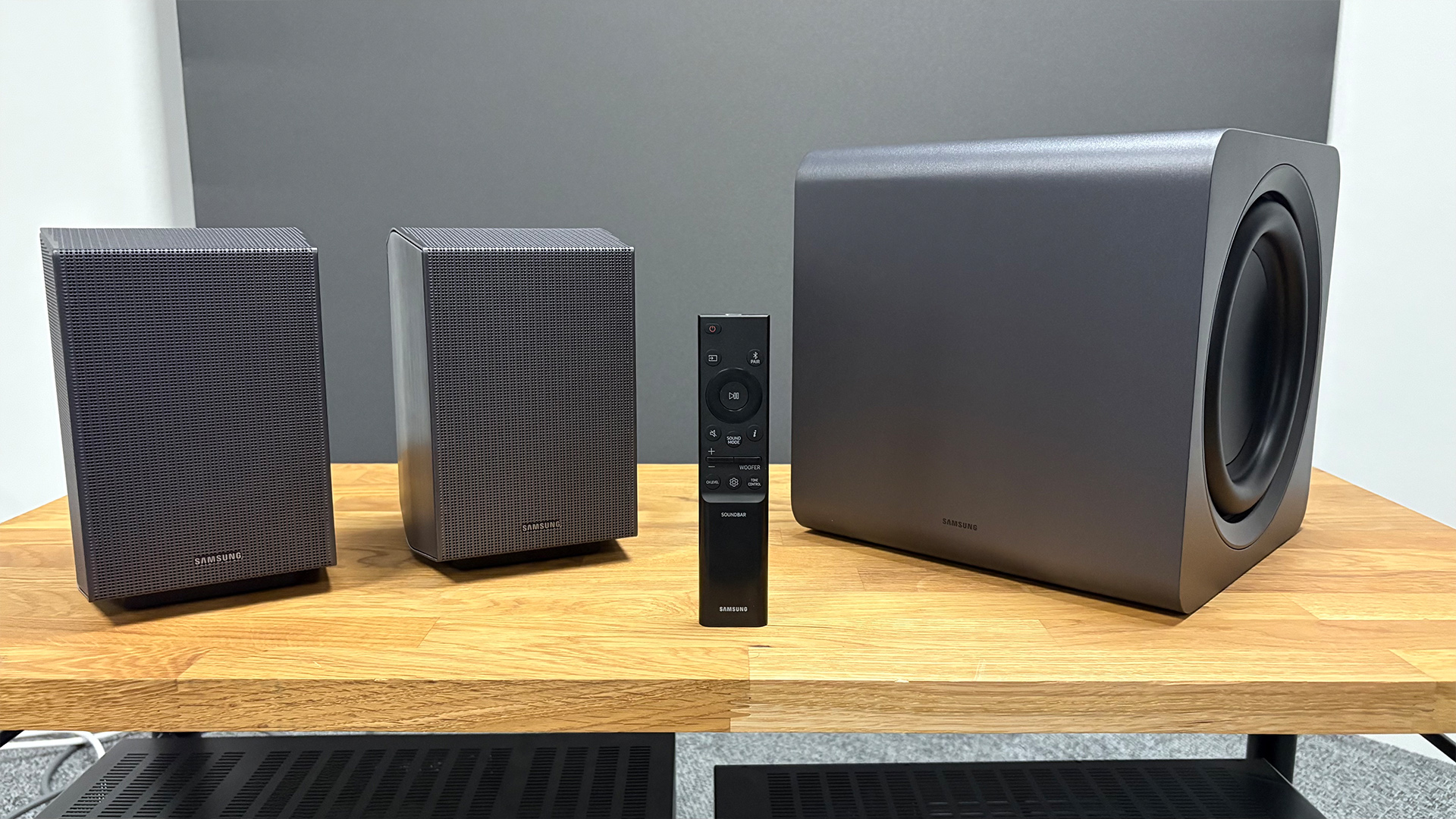
The Samsung HW-Q990F takes a completely different approach, and it's remarkably effective. We are struck by how tonally well-matched the soundbar and surrounds are, while the audio processing ensures sounds move organically between channels. In Blade Runner 2049, for example, the disembodied voices from hologram adverts are placed at an appropriate height and positioned relative to their on-screen location with impressive accuracy.
The new compact subwoofer, though, is the star performer. Where the previous HW-Q990D's sub occasionally showed crackle and unfocused low-end during the Chapter 2 sequence, the HW-Q990F's bass is controlled and dynamic.
We gain a sense of mounting tension as K approaches the police precinct, and there is greater tonal variation from this sub, which unearths a new layer to the bass. It feels more organic, balanced, and seamlessly integrated into the system.
A switch to The Dark Knight Rises' plane-heist sequence reveals the Samsung's convincing surround-sound performance. While height effects aren't as prominent in non-Atmos content, we still hear plenty of effects passed from bar to surrounds in the ensuing chaos. The pulse-pounding battle sequence in Civil War's final third features dynamic build-ups with punchy and weighty payoffs, while immediate shifts such as sudden gunshots are impactful.
For music, both these packages excel beyond typical soundbar standards. The Yamaha delivers that same rich, powerful sound with proper weight and dynamics. Aurora's Churchyard is presented with smooth and powerful delivery, while Bon Iver's From showcases decadent guitar textures.
Samsung’s setup matches this musical prowess. Aurora's Churchyard and Wolf Alice's Bloom, Baby Bloom come through with clear-cut timing and rhythmic drive, actually surpassing the previous model in this regard. Vocals sound clear and emotive, while instruments have depth and texture.
Overall, the critical difference lies in each system’s cohesion. Samsung's components work together seamlessly, creating that bubble of sound we look for in Dolby Atmos systems.
The Yamaha's soundbar and subwoofer are superb, but the surrounds detract from rather than enhance the experience. You could run Yamaha’s setup without the surrounds of course, but that feels wasteful given they're included in the package.
** Winner: Samsung HW-Q990F **
Yamaha True X Surround 90A vs Samsung HW-Q990F: verdict

The Yamaha True X Surround 90A is brilliant on paper – the soundbar and subwoofer combination produces powerful, detailed, tuneful sound with exceptional bass performance.
But the wireless surround speakers simply aren't up to scratch, creating tonal mismatches and gaps in the soundstage that take away from the overall experience. The complex set-up process and lack of automatic calibration features throw extra frustration into the mix.
The Samsung HW-Q990F, by contrast, knows exactly what it wants to be – a complete, cohesive soundbar system that delivers immersive Dolby Atmos without the hassle of an AVR and multiple speakers.
It achieves this with impressive results, delivering transparent, precise sound with seamless integration across all components. The compact cube subwoofer elevates an already superb system into exemplary territory, offering richer, more controlled bass than its predecessor.
If you absolutely must have the most powerful subwoofer and don't mind compromised surrounds, the Yamaha offers that convenience – though you'll need to accept its limitations and fiddly set-up. But for most people seeking exceptional sound quality from a premium soundbar system, the Samsung HW-Q990F represents the smarter investment.
It costs less at the time of writing, sounds better as a cohesive unit, and delivers a more convincing Dolby Atmos experience. In short, Samsung took an already highly regarded product, and made it even better.
** Overall Winner: Samsung HW-Q990F **
MORE
Read our Samsung HW-Q990F review
Check out the best Dolby Atmos soundbars
Read our Yamaha True X Surround 90A review

You must confirm your public display name before commenting
Please logout and then login again, you will then be prompted to enter your display name.